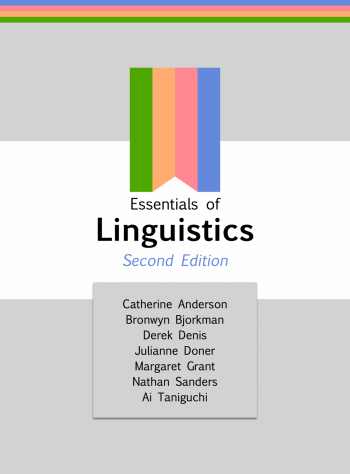Traditional textbooks can be expensive, heavy and quickly outdated. And yet textbooks are also extremely valuable for teachers and students, providing structure for a course and acting as comprehensive guides to the most important elements in a given subject’s curriculum.
So in 2017, when linguistics professor Catherine Anderson of McMaster University created a free online textbook called Essentials of Linguistics, it was received very well — generating downloads from students and instructors in 149 countries interested in an excellent overview of the scientific basis of language.
This year, a book that was already good was made even better, thanks to the contributions of multiple new voices and a new emphasis on accessibility and inclusivity.
Nathan Sanders, assistant professor and undergraduate chair in the Department of Linguistics in the Faculty of Arts & Science, is one of the contributors. He says the idea for the textbook’s second edition came about when a cross-institutional group he belongs to known as the Teaching in Linguistics Community of Practice convened to share ideas.
“We said, we’re sharing all these different ideas and we’ve got experts in different areas, why don’t we update the textbook?” recalls Sanders. “A lot of the issues we were discussing had to do with equity, diversity and inclusion, and certain challenges that students were facing in an online setting. We also knew that linguistics textbooks often face criticism for not including enough information about signed languages, Indigenous languages, or other underrepresented languages. We wanted to make sure we corrected that.”
One of the textbook’s more notable features is the way it highlights social justice in linguistics pedagogy.
Says Sanders: “Most linguistics textbooks have an introductory chapter telling you what language is and what linguistics is, and then they move through the subfields: phonetics, phonology, morphology, syntax, semantics. Then they’ll put some of the other topics at the end, knowing that many people won’t even teach those in their courses.
The open-access nature of this book ties into our goals about equity and inclusion. We wanted it to be equitable and accessible, so that’s why this will be a free resource. It’s clearly something that people want and are using.
“But one of the things we really wanted to do was put a focus on social justice: this gets brought up in multiple places where issues of power and discrimination play a role with how language works. We also wanted to showcase this as an early chapter. So Chapter 2 tells us, here’s how language is used as a tool of discrimination, and here is what you can get out of the course that will help you fight that. We really wanted this to be front and centre in our approach to how linguistics is taught.”
Sanders has long been personally concerned about the connection between social justice and language. During the 2019-2020 school year, he taught a first-year foundations seminar examining the ways language is used as a tool to maintain unjust social structures.
He says that Indigenous, signed and other languages have traditionally been underrepresented in linguistics pedagogy, something his team also sought to correct.
“Other languages have many of the same structures and patterns as spoken English, so their inclusion fits in with the book’s mandate to show how such patterns manifest themselves across different languages,” he says. With Indigenous languages, there was much more to consider.
In one chapter we have recorded interviews with Indigenous scholars who are working with their communities; you hear Indigenous scholars talking about the issues that are important to them. One of the things we wanted to do was to spotlight those perspectives.
“There are larger social issues — residential schools, reconciliation, what’s going on now in these communities, how are they working to keep their languages alive. How do they revitalize them, what kind of work do they do? In one chapter we have recorded interviews with Indigenous scholars who are working with their communities; you hear Indigenous scholars talking about the issues that are important to them. One of the things we wanted to do was to spotlight those perspectives.”
Both Indigenous and Deaf linguists reviewed the book for accuracy. And for the book’s section on signed languages, Deaf instructor David Wiesblatt — who has taught American Sign Language (ASL) at campuses across the country — recorded videos in ASL to demonstrate word and sentence examples.
These examples emphasize how important accessibility is to the authors — its extensive audio and video resources, as well as navigability via screen reader and alt text, all attest to this.
And like the first edition, the updated version is open-access. This means that anyone can download and use it without charge.
As a free, fully digital work in progress, Essentials of Linguistics solves many of the problems attached to old-fashioned textbooks, and may well set standards for those in other fields.
“The open-access nature of this book ties into our goals about equity and inclusion,” says Sanders. “We wanted it to be equitable and accessible, so that’s why this will be a free resource. It’s clearly something that people want and are using.”


